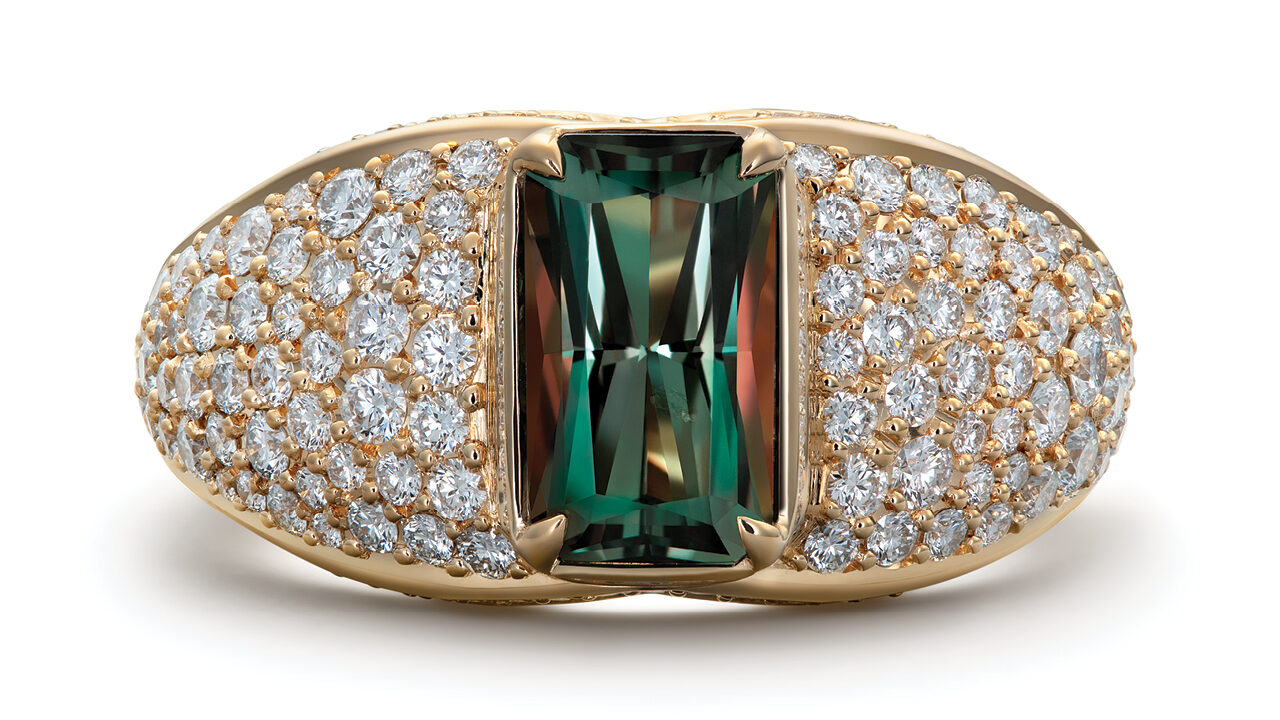This mesmerizing chameleon of a stone is known for its color-changing properties and the rarity of its valuable Russian variety.
One of nature’s rarest gemstones is alexandrite, a captivating stone that changes color from bluish-green in daylight to plum-red under candlelight and incandescent light. This chameleon-esque effect is related to the gem’s pleochroism — meaning it shows different hues when viewed from different angles — and its unusual light-absorbing properties.
Minerals are often named after their discoverers or for gemologists who have made major contributions to the field. But this chromium-bearing variety of chrysoberyl was named for 16-year-old Tsarevich Alexander, the heir to the Russian imperial throne in the 1800s.
Although there’s a great deal of controversy over who discovered it and when, researcher E.V. Burlakov from the Russian Academy of Sciences believes credit should go to Yakov Kokovin, a 19th-century mine manager. Kokovin found the unusual gems in 1831 at an emerald mine in the Ural Mountains, near the Tokovaya River, according to Burlakov. First thinking they were emeralds, Kokovin saw them shift from green in daylight to plum-red by firelight, and realized they were a different material. Later, Count Lev Perovsky, a prominent Russian noble, acquired some of the new gems and sent them for analysis; the results determined that they were a new form of chrysoberyl. Wanting to curry favor with the imperial family, Perovsky named the gem “alexandrite” and presented it to the future Tsar Alexander II on the day he came of age.
Continental drift
In 1898, London jeweler Edwin Streeter wrote in his book Gems that the highest-quality alexandrite came out of the Urals, but only in small numbers; the principal supply was Sri Lanka. Even so, the stones were “far from plentiful,” he said, adding that unlike Russian stones, Sri Lankan specimens appeared green in daylight but had more of a brownish-red hue in incandescent light.
In 1987, alexandrite was found in the Brazilian state of Minas Gerais, which has since become a significant source. While the color change in this material can sometimes be less dramatic than in some of the finer Russian alexandrite, it can still be very pronounced.
The primary sources of alexandrite today are Sri Lanka, Brazil, India, Tanzania and Madagascar, according to Edward Boehm, owner of Tennessee-based gem dealer RareSource. “There is also some new material coming from Zimbabwe that has a strong color change but tends to be rather included,” he says, adding that alexandrite is generally untreated.
“Color change is the most important factor in determining value, then clarity,” explains Niveet Nagpal, owner and designer at California-based brand Omi Privé, which features alexandrite in some of its jewelry lines. “Origin is also a big factor, with Russian being the rarest and most expensive,” and Brazilian fetching a premium as well.
When it comes to demand, “extra-fine alexandrite remains strong, with Brazilian, Indian and Tanzanian [goods] being more desirable than the typically brownish-reds to olive-greens from Sri Lanka,” says Jeffery Bergman, founder of Thailand-based Eighth Dimension Gems. New production from Russia is mostly under 2 carats, and while some excellent color-change goods are available, they are rarely eye-clean, he reports.
Sticker shock
With today’s demand far exceeding the limited supply of Russian alexandrite, such gems are available mainly on the secondary market, says gemologist Alexey Burlakov, son of E. V. Burlakov.
Bergman concurs: “Demand for top old Russian alexandrite has seen several dealers shopping the estate-jewelry market in Japan, where a few top-quality, 1- to near-2-carat gems have shown up.”
Boehm affirms that estate markets have become good sources for the few Russian alexandrites one can find, with prices starting at $35,000 per carat and reaching well over $100,000 per carat for stones above 3 carats. Brazilian specimens, which exhibit a color change of bluish-green to purplish-red, are less expensive, he reports; fine material of 1 to 2 carats usually ranges from $10,000 to $20,000 per carat, while 2- to 3-carat stones can cost $15,000 to $35,000 per carat. Larger sizes up to 5 carats can command per-carat prices of $35,000 to $50,000. Sri Lanka, India and Africa produce more affordable goods, as well as stones over 5 carats, “but the color change is not as strong,” Boehm says.
At Wisconsin-based retailer Luxe Fine Jewelry, most of the customers asking for alexandrite want it because it’s the birthstone for June, says owner and designer Chris Slavens. “When they learn the price, they have sticker shock, not realizing that the price of a ring can exceed that of a diamond piece.” His solution is to offer finer-quality melee stones in a nice pavé band, as this reduces the cost.
Influences of war
With so little production from Russia over the last century and most Russian alexandrite coming from the estate market, the war in Ukraine “has had no direct effect” on supply, according to Boehm. Alexey Burlakov and Nagpal echo this sentiment.
That said, acknowledges Boehm, “the increased cost of fuel [resulting from the war] has affected all gem-producing countries, making it much more expensive to mine with heavy machinery, and thus adding to the lack of supply of all gems globally.”
The Synthetic aesthetic
Because of alexandrite’s beauty, rarity, price and demand — especially in larger sizes and higher qualities — laboratories have looked for ways to grow specimens with the same physical and chemical properties as their natural cousins. In 1972, California-based Chatham Gems announced the successful creation of alexandrite using the flux method. This method involves dissolving the mineral components — in this case, beryllium and aluminum oxide, primarily — in a solvent at high temperatures, and then subjecting the mixture to temperature gradients that cause the minerals to crystallize onto a seed. The growth process takes approximately eight months, according to company CEO Tom Chatham.
“Alexandrite has been a top seller for us for over 40 years,” he says. “The public, especially those wanting June birthstones, are very receptive to lab-grown stones because of the huge price differential with natural alexandrite. Instead of thousands of dollars, our cut stones retail from $400 and up.” The lab-grown stones exhibit the same color change as natural alexandrite, he adds.
Texas retailer Susan Eisen of Susan Eisen Fine Jewelry has seen success with lab-grown alexandrite jewelry. “Since we have a lot of demand for the June birthstone, lab-grown alexandrite is the best — and often only — option for customers who don’t want pearls, the second June birthstone. They appreciate the beauty and color change of alexandrite, but cannot afford the natural gem.”
Regardless of origin, alexandrite is one of nature’s most enchanting stones, and it continues to attract jewelry consumers and collectors.
Image: Kat Florence ring with a 2.15-carat alexandrite and diamonds in 18-karat gold. (Kat Florence)



